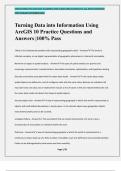Exam (elaborations)
Turning Data into Information Using ArcGIS 10 Practice Questions and Answers |100% Pass
- Module
- Institution
EMILLYCHARLOTTE 2024/2025 ACADEMIC YAER ©2024 EMILLYCHARLOTTE. ALL RIGHTS RESERVED FIRST PUBLISH SEPTEMBER 2024 Page 1/18 Turning Data into Information Using ArcGIS 10 Practice Questions and Answers |100% Pass What is the fundamental problem with representing geographic data? - Answer-The wo...
[Show more]



